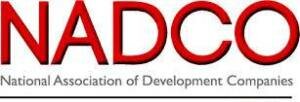Part 4, Special In-Depth Report
For the past three days I’ve been dissecting the 504 results and environment to learn why the CDC/504 program has not been living up to its potential (“What’s Wrong With the 504 Program?,” “Stimulus2: Longest Low-Rate Period Hinders 504 Program,” and Interfraternity Conflict: 7(a) vs. 504, and SBA’s Role).
In this last article, I take these questions home to the CDC’s trade association, NADCO, to air some of the noise you’ll surely hear when searching for 504 solutions.
Ask anyone in the trade about NADCO and the discussion leads to a description of dueling  visions. It’s unclear to me whether it’s “East vs. West,” “Old-Head” vs. “Young Buck,” or just “who’s going to be in charge,” but several sources have told me that tension has been a part of the board for some time.
visions. It’s unclear to me whether it’s “East vs. West,” “Old-Head” vs. “Young Buck,” or just “who’s going to be in charge,” but several sources have told me that tension has been a part of the board for some time.
As for leadership, the organization was headed by Chris Crawford for many faithful years, and no one had anything negative to say about him or his ‘steady as she goes’ approach. But no one said it wasn’t time for a new face either.
Beth Solomon was hired in January, 2013 as an energetic embodiment of a more modern association leader, with good experience in Washington and plenty of relationships in the right places to open some new doors. With more digital savvy and marketing flair, she instigated a make-over of a tired brand.
But apparently her velocity was too much for at least one of those board factions, and that would be the one with the most votes. With writing on the wall, Beth left in June, 2014 after a scant 18-month run.
The timing could have been worse, but without question the high profile turnover costs NADCO critical momentum at a time when they needed to be bearing down on business at hand. While it’s hard enough to get true engagement in DC, it’s impossible without a leader.
Out of Step
In the aftermath of the financial crisis and the marathon stimulus exercise started by the Obama administration, there were plenty of good ideas pulled off the shelf and activated to pump sorely needed dollars into the economy, including in the SBA arena. Bob Coleman likes to remind the world that “SBA did not need a bailout.”
But while Bob was technically correct–there was no immediate liquidity crisis–as insiders, we know that the various routes back to 7(a) and 504 subsidies were well-timed to absorb the rising tide of loan defaults facing the SBA portfolio. On the scale of a federal bailout, like most things SBA it was a rounding error, but a bailout nonetheless.
During this period, the 504 program was armed with two important program initiatives designed to help the greater economy: 1) 504 was for the first time allowed to provide CRE refinancing, and 2) the “First Mortgage Loan Program (FMLP)” was started to replace the secondary market for 504 first mortgages, which had all but disappeared in 2009.
The refinance privilege was huge. The CRE market was frozen due to falling property values in the wake of the crisis. Billions of maturing CRE loans were causing community banks to fail and larger lenders to choke. Ballooning loans couldn’t be renewed because on paper they were underwater, despite unblemished repayment histories.
504 debentures were created with the mandate of ‘economic development,’ which was defined as capital asset acquisition, and generally measured with stipulated job creation/retention metrics. No working capital, no business acquisition and no debt refinancing.
Having the 504 program step up after the crisis with a common-sense product to base loan renewals on borrower credit and repayment history for properties sufficiently margined before the crisis was financial manna from heaven. And it still make sense today in the new normal we are seeing in a different economy.
But in 2010, the SBA took 11 months to promulgate the 504 refinance rules, which was exasperating to borrowers and lenders alike, particularly considering the program was on pilot for only two years. How important did it prove to be? In fiscal year 2012, refinancing was a full one-third of the total 504 volume, meaning over $2.2 billion, or roughly half of the FY 2014 volume.
Once it expired on 9/30/12, consensus was that it would be renewed quickly due to “bipartisan support” on the Hill and its budget neutrality.
But it hasn’t been renewed and since expiration, NADCO has had four different presidents.
In March, 2013, Chris Hurn, founder and former CEO of Mercantile Capital, appeared before the Senate Small Business Committee in support of the 504 program, and in written testimony advocated that Congress explore ending the 504 loan subsidy in order to wean the program off a budget line item and into self-sustainability.
His suggestions were to either implement a modest rise in the statutory limit of the guarantee fee (currently .9375 bps) or marginally raise the third party lender fee (currently 50 bps). He felt that this compromise was necessary to win approval of restoring the Refi program.
Other persons around the industry confirm that some members of the ‘family’ were quite upset with this proposal, seeing the subsidy as a necessary evil for CDCs to be competitive in the market.
NADCO was initially mum on the topic and only later offered tepid support for the idea.
Likewise, the FMLP program encouraged more 504 lending among bank’s who weren’t healthy enough to hold many large loans. With the ability to sell off 85 percent of the balance, they could leverage their capital and use the 504 loan fee income to heal their wounded balance sheets.
Most importantly, the FMLP allowed some financing to continue to special purpose properties who continue to struggle for funding, such as hotels and restaurants. These loans are very important in destination markets like New York, Las Vegas, Atlanta, Orlando, etc. that require a plentiful resupply of hospitality assets to meet their ever-growing demand.
This program also expired on 9/30/12 (having been extended from 2/11) and apparently there’s no discernable discussion around renewing. Many think it’s just too complicated for the average member of Congress to grasp. In fact, many in the 504 industry are ambiguous as to whether it’s really needed. But the fact is, the secondary market for senior loans continues to be meek.
Echoes of Abuse
The December, 2012 high profile shutdown of the 2nd largest CDC, EDF Resource Capital, also didn’t help matters for the 504 program. Citing the relatively large number of non-performing loans and unsuccessful efforts to be paid more than $15 million of owed loss-share obligations, SBA didn’t exactly come out as an example of a good administrator either.
The many program reforms announced in the aftermath are proving onerous for many CDCs that didn’t do anything wrong. And, perhaps some of the more stringent credit standards being applied to the program are directly related to Resource Capital’s failure.
In early 2013, the Coleman Report’s research into CDC executive compensation startled a few folks and revealed the pay disparity between many similarly-sized CDC organizations. It also showed the sometimes disassociation of great business performance and great compensation as well.
Why does NADCO matter?
In August, NADCO’s board announced the hiring of Barbara Vorhyzek as it’s new president and CEO. No stranger to the business, she has been a long time participant, advocate and NADCO insider for many years. Most industry participants I spoke to are hopeful that through her, the organization will balance the needs between the competing ideas for a clear path forward for the 504 program. You can listen to my recent interview with her here.
When asked about the outlook for NADCO, Barbara offered these reflections: “Within the membership of NADCO, we have diverse types of certified development corporations and we have strong-minded people who have their opinions about things, based on the type of organizations they have. ”
She continued, “I think of myself as kind of being brought in at a time when NADCO could really use what I call the “mechanic,” someone who has been in the guts of the machine for decades and has this banking experience that can really understand what it needs and what is helpful for our growth. I think in the end, there will be unification, but it will require time and education for everyone to really see the benefit of the positions that we will ultimately take.”
In the dozens of conversations shared with CDCs, third party lenders and other advocates for the program, all agree that NADCO matters. For better or worse, it’s the recognized voice for 504 in Washington. I heard nothing but positive sentiments that Vorhyzek can effectively lead the industry into its next chapter, but there are formidable challenges ahead, accentuated by the recent election results.
In a mid-August conversation with the former ranking member of the Small Business Committee, Jim Risch (R-Idaho), his comment to me as to the prospects of renewing any enhancements to the CDC/504 program were summarized in two words: “No spending.”






Bookmark this entry